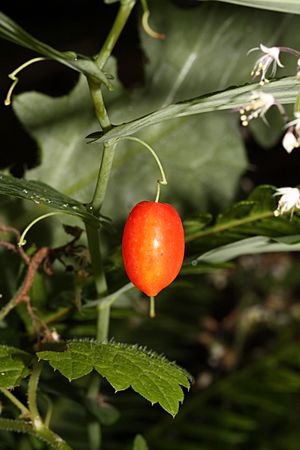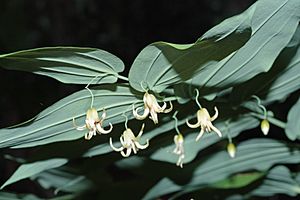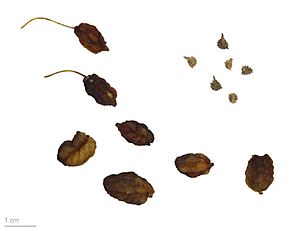Twistedstalk facts for kids
Quick facts for kids Twistedstalk |
|
|---|---|
 |
|
| Squak Mountain State Park | |
| Scientific classification | |
| Genus: |
Streptopus
|
| Species: |
amplexifolius
|
| Synonyms | |
|
Tortipes amplexifolius |
|
Streptopus amplexifolius is a cool plant known by many names. People call it twistedstalk, clasping twistedstalk, claspleaf twistedstalk, white twisted-stalk, or watermelon berry. It's a type of flowering plant in the Liliaceae family, which also includes lilies. You can find this plant growing naturally in North America, Europe, and Asia.
This plant is a herbaceous perennial. This means it's not woody like a tree, and it lives for more than two years. It usually grows to be about 40 to 100 centimeters (16 to 39 inches) tall. Its leaves are long and narrow, about 5 to 14 centimeters (2 to 5.5 inches) in length.
The plant has greenish-white flowers. These flowers hang down from thin, bent stalks that are 1 to 2 centimeters long. Each flower has six white parts called tepals, which are like petals. They are about 9 to 15 millimeters long. The leaves of the plant wrap all the way around the stem. The stem also has a bend where each leaf joins it, making the stem look "twisted" and thin like a wire. Twistedstalk plants often grow low to the ground in wet, thick areas.
Where Does Twistedstalk Grow?
Streptopus amplexifolius is found in many places around the world. In North America, it grows in Greenland, the northern United States (including Alaska), and most of Canada. This includes places like Yukon and the Northwest Territories.
You can often spot this plant near shady stream banks. It also likes moist, thick bushes in mountain areas. These areas are called the montane and subalpine zones.
Beyond North America, it also grows in central and southern Europe. You can find it from Spain all the way to Ukraine. It also reaches as far north as Germany and Poland. In eastern Asia, it's found in Japan, Korea, Myanmar, and eastern Russia. This includes regions like Yakutia, Amur, Kamchatka, Sakhalin, and the Kuril Islands.
Uses and What It's Like to Eat
Long ago, Native Americans in Eastern North America used Streptopus amplexifolius for food and medicine. Early settlers in North America sometimes called it "wild cucumber" or "scoot berries." They called the berries "scoot berries" because eating too many could make you go to the bathroom a lot!
Some Native American groups ate the young, soft shoots of this plant as a salad green. However, most people thought the plant and its berries were poisonous. The shoots are said to be sweet and taste a bit like cucumber. The berries are juicy and sweet, with a flavor like watermelon. Native Americans also used the juice from the berries to help soothe burns.
How to Tell Twistedstalk Apart
Twistedstalk looks a bit like another plant called False Solomon's Seal (Maianthemum racemosum). But there's an easy way to tell them apart. Twistedstalk has its flowers and fruits growing along the stem, right where the leaves join. False Solomon's Seal, however, has all its flowers at the very top of the stem.
Also, False Solomon's Seal always has a single, unbranched stem. Twistedstalk, on the other hand, can have branches near the bottom. When Twistedstalk has fruit, it's very easy to spot. It has large, juicy red berries that grow from each leaf. These bright red berries stand out, even in thick plants around them.

When Twistedstalk plants are young, they can look like plants from the Veratrum group. These Veratrum plants are also in the lily family, but they are very poisonous. Because of this, you should never eat Twistedstalk unless you are absolutely sure you have identified it correctly. It's always best to be safe!



